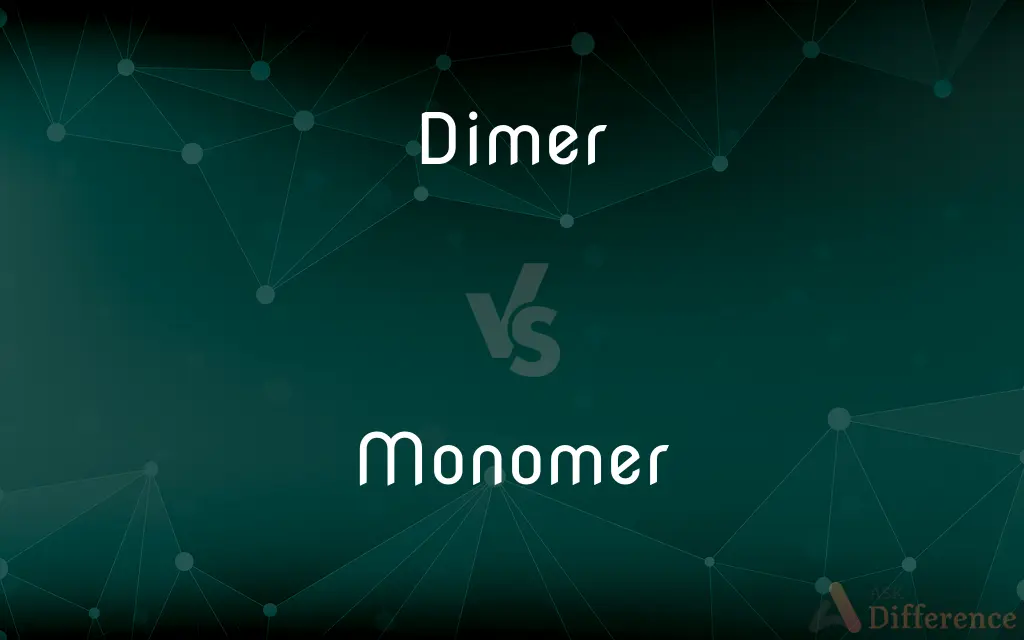Dimer vs. Monomer — What's the Difference?
By Tayyaba Rehman & Urooj Arif — Updated on March 7, 2024
A dimer is a molecule composed of two identical or similar subunits (monomers) bonded together, while a monomer is a single molecule that can bind to other identical molecules to form a polymer.

Difference Between Dimer and Monomer
Table of Contents
ADVERTISEMENT
Key Differences
A monomer is the simplest unit of a polymer, representing the building block from which larger molecules are constructed. Monomers can bind chemically to other monomers to form more complex structures, including dimers, trimers, and polymers. A dimer, on the other hand, is a specific type of polymer that consists of only two monomer units bonded together. Dimers can be formed from two identical monomers, known as a homodimer, or from two different monomers, known as a heterodimer.
The bond between the monomers in a dimer can be strong covalent bonds or weaker forces such as hydrogen bonds, depending on the nature of the monomers and the conditions under which they combine.
The transition from monomer to dimer (or further into larger polymers) is crucial in various biological and chemical processes. For example, many biologically significant molecules, such as nucleic acids and proteins, are polymers formed from monomers (nucleotides and amino acids, respectively). Dimers play important roles in various biological functions, including enzyme catalysis and the regulation of biological processes.
Monomers are versatile and can participate in various types of polymerization reactions to form different kinds of polymers, showcasing the diversity of chemical structures they can create. Dimers represent a simple form of polymers that exemplify the basic principle of polymerization, where monomer units are linked together.
Understanding the distinction between monomers and dimers is fundamental in the study of chemistry and biology, particularly in the fields of polymer science, biochemistry, and molecular biology, where the structure and function of molecules are key to understanding complex biological systems and materials science.
ADVERTISEMENT
Comparison Chart
Definition
A single molecule that can bind to other identical molecules to form a polymer.
A molecule composed of two bonded monomers, either identical or different.
Complexity
Simplest unit, single molecule.
More complex, consisting of two monomer units.
Types
Can be identical or have different functional groups.
Homodimer (identical monomers) or heterodimer (different monomers).
Role
Building blocks for polymers and larger molecular structures.
Specific form of polymer, illustrating the principle of monomer bonding.
Significance
Fundamental in the formation of polymers and understanding polymerization.
Important in various biological functions and chemical processes.
Compare with Definitions
Dimer
A molecule consisting of two bonded monomers.
The dimer of acetic acid forms acetic anhydride.
Monomer
The simplest unit from which polymers are constructed.
Glucose is a monomer that can polymerize to form starch or cellulose.
Dimer
Can occur through various bonding mechanisms.
The nitrogen bases in DNA can form dimers when exposed to UV light.
Monomer
Determines its ability to form polymers.
Ethylene is a monomer with a double bond, allowing it to polymerize into polyethylene.
Dimer
Homodimers and heterodimers, based on the monomer units.
Collagen is a protein that forms heterodimers.
Monomer
Can form various types of polymers through different polymerization reactions.
Amino acids are monomers that polymerize to form proteins.
Dimer
Plays roles in enzyme catalysis and regulation of biological processes.
The hormone receptor dimerizes upon hormone binding, initiating a signal transduction pathway.
Monomer
Used in the synthesis of plastics, resins, and other polymeric materials.
Vinyl chloride monomer is used to produce PVC, a widely used plastic.
Dimer
Important in understanding the principles of polymerization and molecular interactions.
The study of hemoglobin dimers is crucial for understanding oxygen transport in the blood.
Monomer
Constitutes the basic units of essential biological polymers.
Nucleotides are the monomers that make up DNA and RNA.
Dimer
A chemical compound or molecule consisting of two identical simpler molecules.
Monomer
A monomer ( MON-ə-mər; mono-, "one" + -mer, "part") is a molecule that can react together with other monomer molecules to form a larger polymer chain or three-dimensional network in a process called polymerization.
Dimer
(chemistry) A molecule consisting of two identical halves, formed by joining two identical molecules, sometimes with a single atom acting as a bridge.
Monomer
A molecule that can be bonded to other identical molecules to form a polymer.
Dimer
A compound whose molecules are composed of two identical monomers
Monomer
A molecule that can combine with other molecules to form a polymer.
Monomer
(chemistry) A relatively small molecule which can be covalently bonded to other monomers to form a polymer.
Monomer
The basic conceptual building unit of a polymer; a molecule of low molecular weight which may combine with other molecules to form a molecule in a chain or branched form having high molecular weight; as, amino acids are the monomer units which are combined to form proteins; vinylic plastics are formed from monomers having a vinyl group.
Monomer
A simple compound whose molecules can join together to form polymers
Common Curiosities
Are all polymers made from monomers?
Yes, all polymers are made from monomers, though the types and arrangements of monomers can vary widely, leading to diverse polymer structures.
Can dimers dissociate back into monomers?
Yes, under certain conditions, dimers can dissociate back into monomers, depending on the strength and type of bond between the monomers.
How does the functionality of a monomer affect polymerization?
The functionality of a monomer, or the number of reactive sites it has, determines how it can polymerize and the structure of the resulting polymer.
Why is the study of monomers and dimers important in materials science?
Understanding monomers and dimers is crucial in materials science for designing and synthesizing new materials with tailored properties for specific applications, such as strength, flexibility, or chemical resistance.
How are monomers selected for polymerization?
Monomers are selected based on their chemical reactivity, the desired properties of the polymer, and the specific application or function of the resulting material.
What role do dimers play in biological systems?
Dimers are involved in various biological processes, including enzyme activity, signal transduction, and structural roles in cells and tissues.
Can dimers form more complex structures?
Yes, dimers can further associate into trimers, tetramers, or higher-order structures, contributing to the complexity and functionality of biological molecules and materials.
What distinguishes a covalent bond in a dimer from weaker interactions?
A covalent bond involves the sharing of electrons between atoms, resulting in a stronger and more stable connection, whereas weaker interactions, like hydrogen bonds, are based on electrostatic attractions and are more easily reversible.
How do environmental factors influence dimerization?
Factors like temperature, pressure, and the presence of catalysts can affect dimerization by altering the rate of reaction, the equilibrium between monomers and dimers, and the stability of the dimer formed.
Can the formation of dimers affect the properties of a substance?
Yes, dimerization can significantly alter the physical and chemical properties of a substance, including its boiling point, melting point, and reactivity.
Are there any specific techniques used to study dimers and their formation?
Techniques such as spectroscopy, chromatography, and X-ray crystallography are used to study dimers, providing insights into their structure, formation mechanisms, and interactions.
How can monomer purity affect polymerization outcomes?
Impurities in monomers can lead to defects in the polymer structure, affecting its overall properties, performance, and quality.
How do reversible dimers play a role in dynamic chemical systems?
Reversible dimers can act as regulatory elements in dynamic chemical systems, responding to environmental changes and participating in equilibrium reactions that are crucial for processes such as signal transduction and metabolic regulation.
What is the significance of dimerization in pharmaceuticals?
Dimerization can influence the efficacy, stability, and delivery of pharmaceutical compounds, impacting their therapeutic potential and side effects.
Can dimers be intentionally created for specific functions?
Yes, dimers can be synthetically designed and created to perform specific functions, such as in catalyst design, sensor development, and in the creation of novel materials.
Share Your Discovery

Previous Comparison
Unified vs. United
Next Comparison
Failure vs. FailAuthor Spotlight
Written by
Tayyaba RehmanTayyaba Rehman is a distinguished writer, currently serving as a primary contributor to askdifference.com. As a researcher in semantics and etymology, Tayyaba's passion for the complexity of languages and their distinctions has found a perfect home on the platform. Tayyaba delves into the intricacies of language, distinguishing between commonly confused words and phrases, thereby providing clarity for readers worldwide.
Co-written by
Urooj ArifUrooj is a skilled content writer at Ask Difference, known for her exceptional ability to simplify complex topics into engaging and informative content. With a passion for research and a flair for clear, concise writing, she consistently delivers articles that resonate with our diverse audience.














































